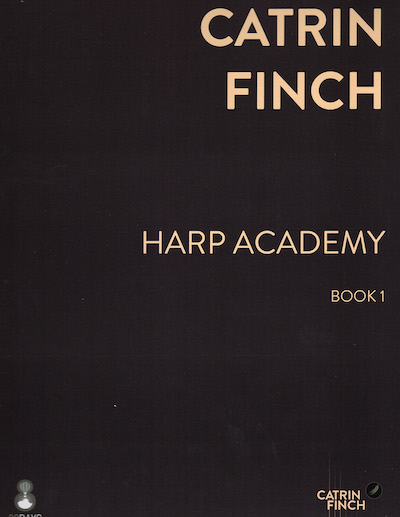Looking for some new instructional material? There are some new publications worthy of consideration.

Reidun Lynch, www.harpmusic.ie, has recently published Making Progress on the Irish Harp. Subtitled “Songs and Tunes from Ireland,” the book contains 35 pages of tunes for Celtic harp and information geared for beginners of any age group.
All the music requires a harp set to G major. Lynch begins by instructing players which levers to raise to get into G major for harps tuned to E-flat or tuned to C major. For those playing harps with no levers, she suggests getting assistance to tune the Fs to sharp. She uses the European terms semiquavers, quavers, crotchets, and minims for sixteenth, eighth, quarter, and half notes. There is a quick review of the notes of the scale as presented in her previous, more introductory manual, My Little Irish Harp Book (Book 1). This previous book is directed at children.
Her approach is simple and minimalist, but she manages to explain note values, fingering, time and key signatures, scales, intervals, chords, modes, and numerous other musical terms and concepts. There is a glossary of musical terms used in the book and 22 fairly easy Irish tunes.
There is a lot of information that could be overwhelming for a student new to music. For example, there is just a cursory explanation of modes, although it is pretty clear. Most students need frequent repetition of these concepts in order to securely instill them, but, combined with the guidance of a qualified teacher, this text is a valuable resource.

There is another useful textbook coming to us from across the pond from former Royal harpist Catrin Finch. Harp Academy, Book 1 is published by 80 Days Publishing and emphasizes establishing solid technique. There are 65 pages of exercises and etudes that progress fairly quickly, so beginners may find some of them quite challenging.
The first chapter focuses on getting good tone while having good control over the fingers working together. Chapter 2 concentrates on scales. Chapter 3 introduces arpeggio patterns and Chapter 4 highlights chords. Chapter 5 features trills and bisbigliando. Scales are re-visited in Chapter 6, but this time in groups of thirds, fifths, and sixths. Extended techniques including prés de la table, harmonics, etouffées, glissandi, and knocking on the soundboard are covered in Chapter 7. Some excellent photographs of the hands executing harmonics and etouffées were included. Less advanced players would benefit if additional illustrations of the soundboard knocking had been presented as well. Chapter 8 contains a scale study, an arpeggio study, a chord study, and an extended study that combines all of the techniques covered in the book. No pedaling is necessary until these final etudes.
This 65-page volume is spiral-bound so it lays flat on the music stand and the music is printed on non-glaring, ecru paper. The preface appears in both Welsh and English and explains Finch’s core concepts for good technique. The exercises may be a little advanced for beginners, but intermediate or better players will find these exercises progress in a logical manner and emphasize good technique.

Anna Pasetti has edited 58 Technical Exercises for Harp by François-Joseph Dizi. The book is published by UTOrpheus on oversized ecru paper. The preface contains the history of how Dizi eventually ended up in Paris—a fantastic story that supports the adage that truth is stranger than fiction.
In a nutshell, around 1796, Dizi was on the deck of a ship in port that was taking him to London when he saw a seaman fall into the ocean. He jumped in to save him, not remembering that he didn’t know how to swim! A laborer saved Dizi and when he awoke, he realized he didn’t know the name of his ship that carried all his belongings, including his harp, clothing, and money. The ship had continued on its journey as no one had noticed Dizi’s plunge into the water. He eventually made it to London, but never found his ship and spoke no English. He spent several weeks lost in the big city until by chance he passed a house where he could hear a harp being played. It turned out to be the home of Sebastian Erard. Dizi asked Erard to listen to him and Erard, recognizing Dizi’s talent, helped him get established as a teacher. Dizi spent 30 years enjoying a brilliant career in London before moving to Paris in 1830. He was not only a harpist, composer, and teacher, but also a harp maker.
They would make excellent warmups for the intermediate and advanced player and should definitely help develop facility on the harp.
These exercises are taken from Dizi’s harp method book. The first 18 exercises are mostly variations on scale patterns using various finger orders. Most of them have the two hands playing in unison and some of them have the two hands harmonizing or the left hand starting two notes after the right hand so that the hands perform the same configurations but at different times. The remaining exercises are mostly arpeggio patterns. Sometimes the hands play in different directions. Sometimes the placed fingers play out of order, e.g. 4, 2, 3, 1. Many of them are brain-teasers, at least to play with any speed.
Among Dizi’s goals for these exercises was to develop the ability for the fingers of each hand to work independently. You will certainly develop that skill by mastering these exercises. No pedals are required as all the exercises are in the key of C. They would make excellent warmups for the intermediate and advanced player and should definitely help develop facility on the harp.

One final book, Charlie’s Birthday, is a musical tale intended for children ages three to seven. It was written and published by the multi-talented harpist Isabelle Frouvelle (Editions Le Livre et la Harpe) who not only wrote the story, but also did the illustrations and composed the music that accompanies the story. While not exactly instructional, Frouvelle’s hope was that these tunes might be played in class as part of an educational project as well as just for fun.
This adorable book tells the story of a kitten who was forbidden to eat chocolate by his parents because of the mess he makes when he eats it. Twelve little tunes are included to play or listen to while reading the story. There are QR codes at the beginning of each score—a simplified version—that can be scanned with a smartphone, allowing the reader to listen to the music played on the harp. When you purchase the book, other versions can be downloaded free for advanced harp, flute and harp, two harps, and piano, four hands.
Young children will enjoy this colorful and entertaining paperback and teachers may like some of Frouvelle’s other instructional books aimed at young beginners available on her website. •







